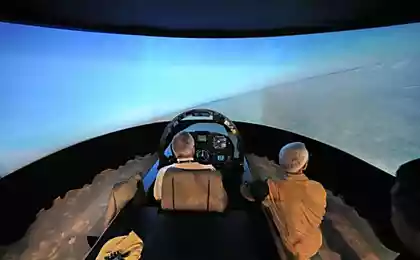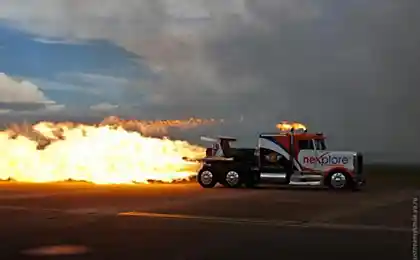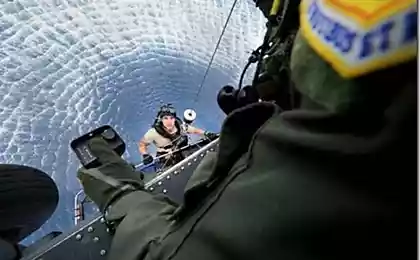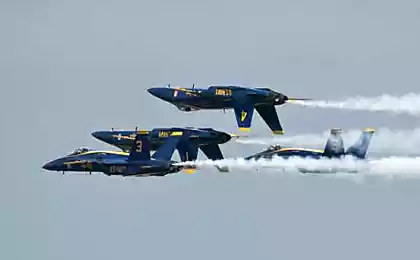669
Walk on the Berlin Air Show
There is a lot of photos and descriptions of about 90 most interesting in my view photos of correction and additions are welcome.
Let's go ...
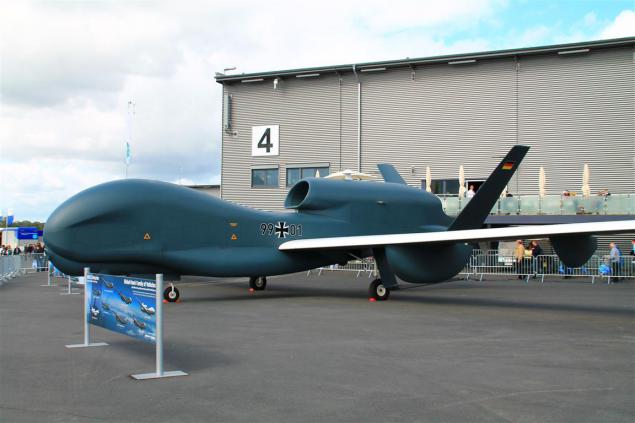
RQ-4 Global Hawk - US strategic reconnaissance UAVs.
First flew on February 28, 1998 with the US Air Force Base in California. The first Global Hawk unit was handed over to the naval forces of the United States in 2004 and began to carry out combat missions in March 2006.
The apparatus may patrol for 30 hours at an altitude of 18 to 000 meters. Developed by US company Teledyne Ryan Aeronautical, a subsidiary of Northrop Grumman.
In January 2012, the US Air Force decided to stop buying Northrop Grumman RQ-4 Global Hawk Block 30. modifications in adopting earlier devices zaplainirovano transfer to the reserve (citation). The reason for this decision was their expensive service, far exceeding the operating costs Lockheed U
Global Hawk UAV The complex consists of an air segment, ground segment, the segment of service, as well as trained staff. Air segment includes UAV directly with various sensors, avionics and communication systems. The ground segment consists of equipment and start of service (Launch and Recovery Element), ground control system (Mission Control Element) with built-in terrestrial communication equipment. To improve the mobility of all ground equipment placed in containers or on special trailers.
Global Hawk is equipped with an integrated system of surveillance and reconnaissance HISAR (Hughes Integrated Surveillance & Reconnaissance). This is a simplified and cheaper version of the complex ASARS-2 was developed by Hughes for the spy plane Lockheed U-2. This complex is also used aboard the army UAV RC-7B and sold on the international market. The complex includes a radar SAR / MTI, as well as optical and infrared sensors. The three subsystems can operate simultaneously, and data processed by a single processor. Digital data may be transmitted to the ground in real time within a line of sight or via the satellite channel with speeds up to 50 Mbit / s.
Synthetic aperture radar manufactured by Raytheon (Hughes) and is designed to work in all weather conditions. In normal operation it provides a radar image area with a resolution of 1 meter. During the day, the image may be obtained from an area of 138, 000 square kilometers at a distance of 200 km. In point mode («spotlight» mode), the area of shooting a 2 x 2 km for 24 hours can be obtained more than 1,900 images with a resolution of 0, 3 m Global Hawk has a broadband satellite link and the link within the visible area. Subsystem SAR / MTI operates in the X band and provides:
Scanning and detection of moving targets within a radius of 100 km
Combined SAR / MTI mode provides the ability to monitor with a resolution of 6 meters in a strip width of 37 km and a length of 20 to 110 km.
In the detailing radar provides a resolution of 1, 8 meters in the territory of 10 square meters. km.
The radar is capable of detecting land mobile (moving target indicator - MTI) and the transmission of information on similar properties (position and velocity) in text messages.
Daily electro-optical digital camera manufactured by Hughes and provides high-resolution images. The sensor (1024 x 1024 pixel) is associated with a telephoto lens with a focal length of 1750 mm. Depending on the program, there are two modes of operation. The first - the scan width of 10 km. The second - a detailed view of the area of 2 x 2 km.
Images obtained with the radar and EO / IR sensors are processed on board the UAV and transmitted to a ground station in the form of individual frames. The ground station collects from the image frames and prepares them for future use.
To navigate using inertial amended by GPS. Global Hawk is designed for free flight and transfer of intelligence through satellite (Ku-band and VHF) to a ground station. In the case of UAVs in the line of sight it is possible to transfer data directly to a suitable ground station.
The ground segment consisting of equipment startup and maintenance (Launch and Recovery Element) and a ground control system (Mission Control Element), also manufactured by Raytheon. MCE is used for setting goals, management and control, processing and transmission of images. LRE is designed to run the search and UAVs. As part of LRE has equipment to calculate the differential correction GPS system to determine the exact position naviagatsionnogo UAV during take-off and landing. The rest of the main navigation tool is the inertial system (as amended on GPS). During missions MCE and LRE are located in different places (MCE is usually found in the location of the command). Both systems are included in the ground segment are placed in fortified shelters with external anntenami direct and satellite communications.
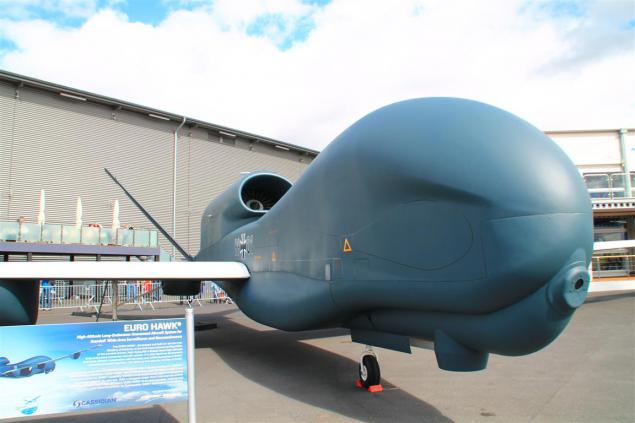
...
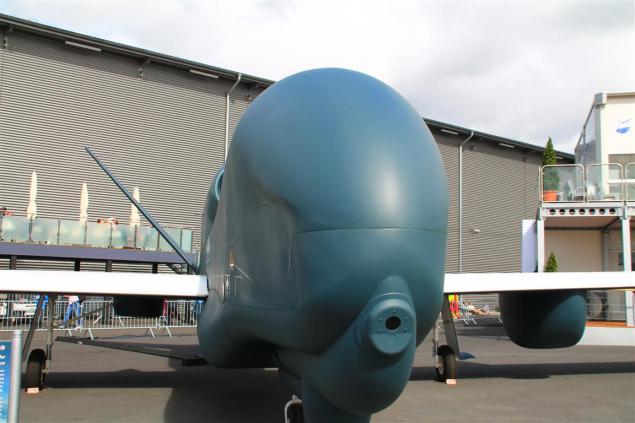
Eurocopter Tiger / Tiger Eurocopter Tiger - reconnaissance and attack helicopter. Designed Franco-German consortium Eurocopter.
History of
Based on the results of computer simulation of a combat helicopter operation and analysis of their application in local military conflicts, the mid-1980s among aviation experts the US and NATO spread notion that the survival of the helicopter in the future will increasingly be determined not survivable structure and level of visibility helicopter in the basic physical fields used complex electronic warfare and tactical methods employed perfection. Here, the survival machines meant the loss rate - ratio of the number of downed helicopters to the total number produced departures. However, consideration of the design principles used, structural layout solutions and features RAH-66 helicopters, Eurocopter Tiger, and others. No reason to talk about the abolition of the requirements to ensure survivability, it is likely to change the ranking of priorities and requirements.
The fuselage is 80% of the polymer composite materials (PCM) based carbon fiber and Kevlar 11% are aluminum, and 6% of titanium alloys. The blades and tail rotor made from composite materials and is able to operate under combat injuries and collisions with birds. Lightning protection and resistance to electromagnetic pulse (EMP) provides a thin bronze mesh and copper connecting foil deposited on the surface of the fuselage.
Location of the crew - the standard for the attack helicopters - tandem feature of the helicopter "Tiger" is the front-pilot's seat, the operator's station - behind. Thus the pilot seat and the operator offset in opposite directions relative to the longitudinal axis of the vehicle to provide better viewing of the front of the operator from the rear seat. Survivability and security
The equipment includes an onboard detectability complex AN / AAR-60 MILDS, warning the crew of the helicopter irradiation enemy radar, laser guidance systems and aiming, and start-up / attack missiles. The complex is designed by the German branch of the consortium EADS. All systems are closed to the onboard computer commands which are fed to the machine reset antiradar reflectors and infrared jamming devices company MBDA. The helicopter tools installed EW EloKa. To minimize the visibility of the characteristics of the helicopter in the optical, radar, infrared and acoustic bands.
Function maintenance systems on board the helicopter and provides the ability to continue the flight with the defeat of a single 23-mm projectile OFZ. Cockpit Protection is ensured by the combined armor AMAP-AIR
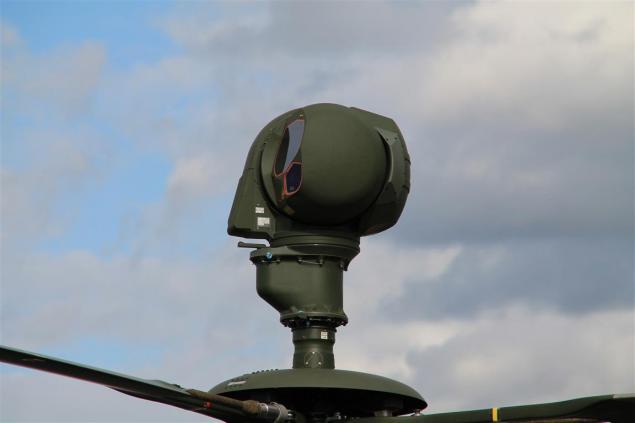
...
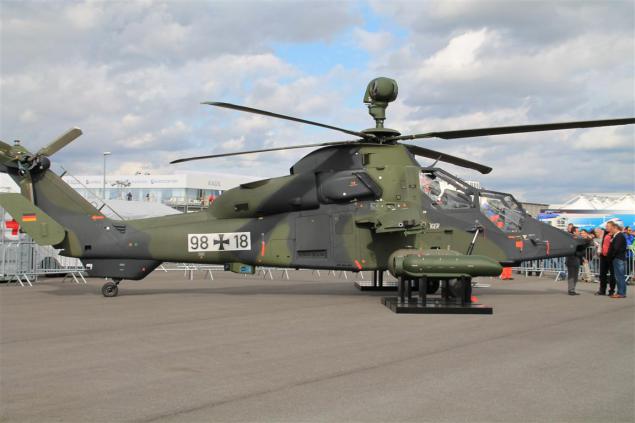
...

...
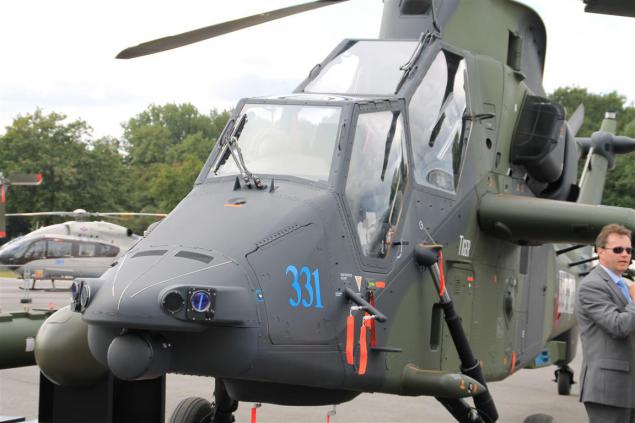
...
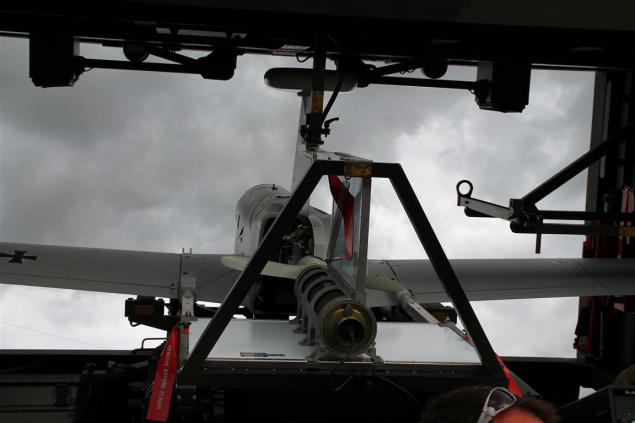
...
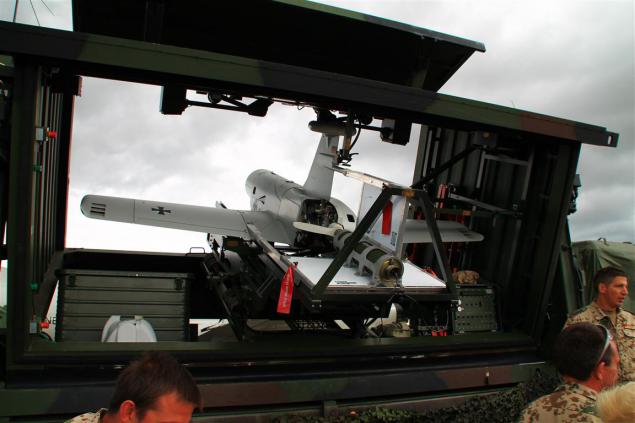
...

Boeing C-17 "Globemaster» III Boeing C-17 Globemaster III - US strategic military transport aircraft. Designed to replace the C-141 "Starlifter". It made its first flight on Sept. 15, 1991. Currently, this type of aircraft in service with the US Air Force and six other countries
Flight characteristics
Maximum speed: 833 km / h at an altitude of 8534 m
Cruising speed at low altitude: 648 km / h
Ferry range of flight: 8710 km
Flight range:
with a load weight kg 56 245 - 5190 km
with a cargo weighing 76,650 kg - 4445 km
Service ceiling: 13,715 m
Takeoff run with maximum payload of 2 360 m
The path length with a maximum payload of 915 m (with thrust reversers)
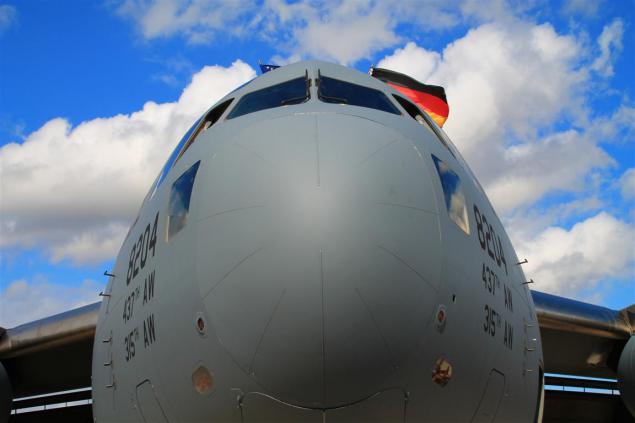
...

...
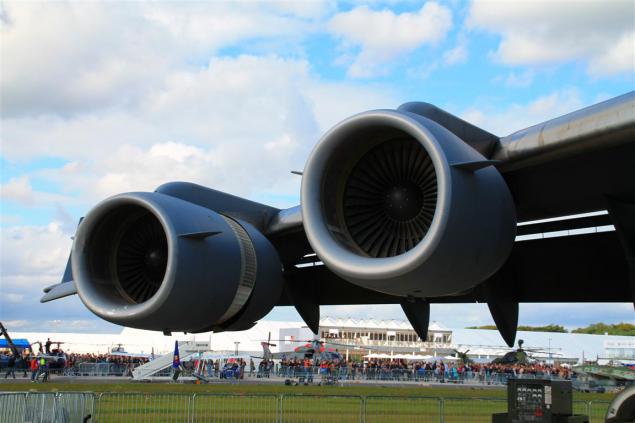
...

...

Eurocopter X3 (Eurocopter X3, X-Cube) - a pilot hybrid helicopter (rotorcraft), created by Eurocopter. It was created with the purpose of the possibility of flying at a speed of 410 km / h. The main rotor of the helicopter has five blades on the ends of the wings have more push and propellers with five blades, tail rotor no. Compensation of reactive torque generated by the rotation of the rotor, is provided by the side propellers. The power plant consists of two engines Rolls-Royce Turbomeca RTM322.
The first flight took place on September 6, 2010 in France. May 12, 2011 X3 reached a speed of 430 km / h
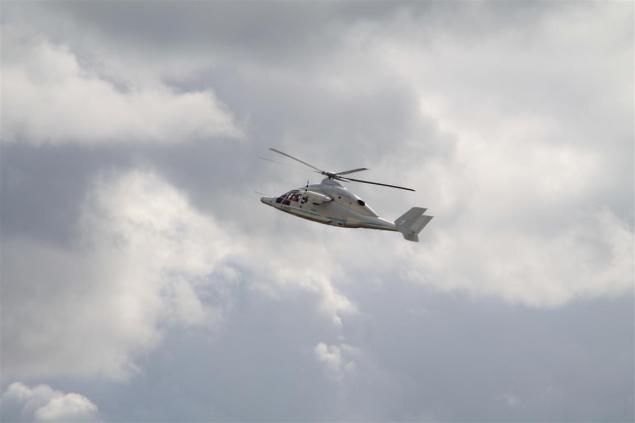
...
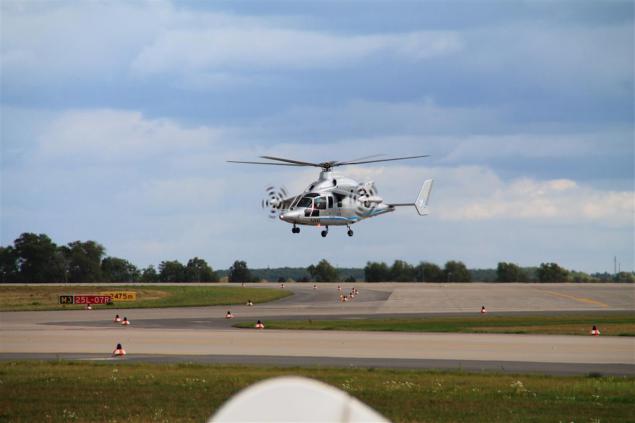
Eurofighter Typhoon (Eng. Eurofighter Typhoon) - multi-role fighter with canards. Early models are Typhoon fighter 4th generation and later modified - prospective studies 4+ generation aircraft began in 1979.
Currently conducted mass production fighter.
The aircraft delivered to the Air Force in Germany, [4] Italy, Spain and the UK. Austria has ordered 15 fighter "Typhoon».
Design:
Design features fighter reflect the desire of developers to use the latest world achievements in the field of aircraft construction and electronics. In order to ensure the required level of maneuvering characteristics, particularly at high angles of attack, the aircraft is designed for scheme with low delta wing (sweep angle of 53 degrees) and a negative margin of stability, two-piece flaps and slats, turning canards (PGO), vertical fin and rudder without stabilizer. Such a scheme has a number of advantages, the main of which - reducing aircraft drag at supersonic speeds.
Fuel is located in the fuselage and wing fuel tanks, fully occupying the caissons wing panels.
On the "Typhoon" applied fourfold redundant digital-wire flight control system, combined with the engine management system. It provides an artificial stability and maneuverability, as well as the deviation of the controls to achieve maximum aerodynamic efficiency in all modes and at all speeds and altitudes.
Reduced radar signature:
Although the new fighter does not belong to the category of aircraft (LA), made by technology "stealth" in its design was made a number of design and layout of measures aimed at reducing the effective surface scattering (EPR). In the design was tasked to reduce the ESR of the aircraft from the front angle of irradiation radar four times compared to the value of the aircraft Panavia "Tornado". [6] Some of these measures include: drowning and masked input devices air intakes front end engines (strong source of reflection of electromagnetic radiation). A number of important elements of the reflectivity of the construction plane (the plane bearing, the front edge of the horizontal tail components - Cunard and stabilizer) differ a large scale, by virtue of which have good reflectivity in the anterior sector. External suspension semiflush made guided missiles that can partially screen the design of the aircraft missiles on the suspension of the incident electromagnetic radiation. Leading on the reflectivity of land and construction elements fighter "Eurofighter" covered with radar absorbing materials, mainly the development of the group EADS / DASA. These are: the front edge of the wing leading edge and the inner surface of the air intakes, the rudder and the adjacent surface, and so on. N. We fighter "Typhoon" no internal weapons bays. Instead, they use nodes external suspension, worsens the EPR, but at the same time allowing to expand the range of options and used weapons.
Armament
Cannon armament: 1 × 27 mm gun Mauser BK-27 at the root of the right wing
Suspension points: 13
The combat load: ~ 6500 kg of various weapons
Missiles "air-to-air
Missiles "air-to-air
Bombs
The laser system targeting
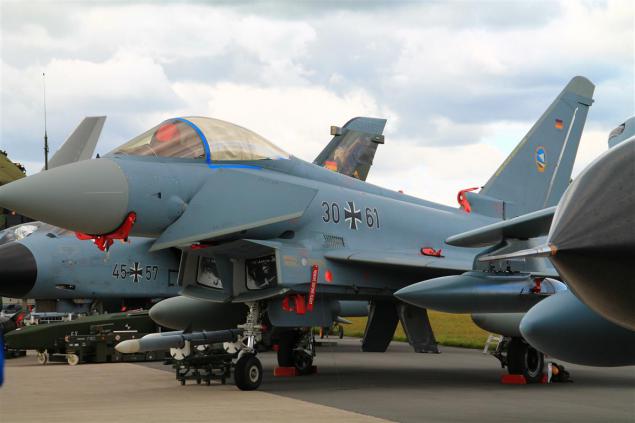
...
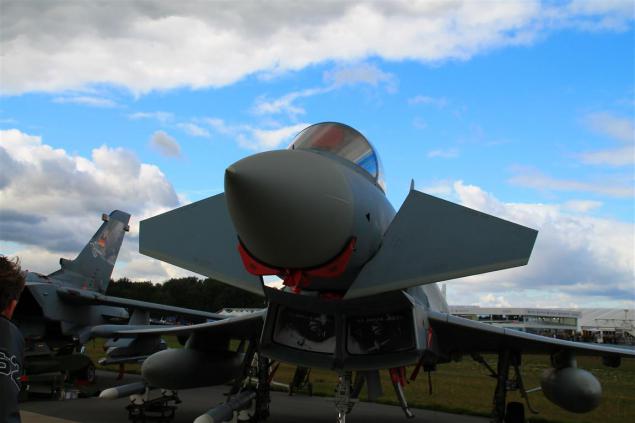
Source:
Let's go ...

RQ-4 Global Hawk - US strategic reconnaissance UAVs.
First flew on February 28, 1998 with the US Air Force Base in California. The first Global Hawk unit was handed over to the naval forces of the United States in 2004 and began to carry out combat missions in March 2006.
The apparatus may patrol for 30 hours at an altitude of 18 to 000 meters. Developed by US company Teledyne Ryan Aeronautical, a subsidiary of Northrop Grumman.
In January 2012, the US Air Force decided to stop buying Northrop Grumman RQ-4 Global Hawk Block 30. modifications in adopting earlier devices zaplainirovano transfer to the reserve (citation). The reason for this decision was their expensive service, far exceeding the operating costs Lockheed U
Global Hawk UAV The complex consists of an air segment, ground segment, the segment of service, as well as trained staff. Air segment includes UAV directly with various sensors, avionics and communication systems. The ground segment consists of equipment and start of service (Launch and Recovery Element), ground control system (Mission Control Element) with built-in terrestrial communication equipment. To improve the mobility of all ground equipment placed in containers or on special trailers.
Global Hawk is equipped with an integrated system of surveillance and reconnaissance HISAR (Hughes Integrated Surveillance & Reconnaissance). This is a simplified and cheaper version of the complex ASARS-2 was developed by Hughes for the spy plane Lockheed U-2. This complex is also used aboard the army UAV RC-7B and sold on the international market. The complex includes a radar SAR / MTI, as well as optical and infrared sensors. The three subsystems can operate simultaneously, and data processed by a single processor. Digital data may be transmitted to the ground in real time within a line of sight or via the satellite channel with speeds up to 50 Mbit / s.
Synthetic aperture radar manufactured by Raytheon (Hughes) and is designed to work in all weather conditions. In normal operation it provides a radar image area with a resolution of 1 meter. During the day, the image may be obtained from an area of 138, 000 square kilometers at a distance of 200 km. In point mode («spotlight» mode), the area of shooting a 2 x 2 km for 24 hours can be obtained more than 1,900 images with a resolution of 0, 3 m Global Hawk has a broadband satellite link and the link within the visible area. Subsystem SAR / MTI operates in the X band and provides:
Scanning and detection of moving targets within a radius of 100 km
Combined SAR / MTI mode provides the ability to monitor with a resolution of 6 meters in a strip width of 37 km and a length of 20 to 110 km.
In the detailing radar provides a resolution of 1, 8 meters in the territory of 10 square meters. km.
The radar is capable of detecting land mobile (moving target indicator - MTI) and the transmission of information on similar properties (position and velocity) in text messages.
Daily electro-optical digital camera manufactured by Hughes and provides high-resolution images. The sensor (1024 x 1024 pixel) is associated with a telephoto lens with a focal length of 1750 mm. Depending on the program, there are two modes of operation. The first - the scan width of 10 km. The second - a detailed view of the area of 2 x 2 km.
Images obtained with the radar and EO / IR sensors are processed on board the UAV and transmitted to a ground station in the form of individual frames. The ground station collects from the image frames and prepares them for future use.
To navigate using inertial amended by GPS. Global Hawk is designed for free flight and transfer of intelligence through satellite (Ku-band and VHF) to a ground station. In the case of UAVs in the line of sight it is possible to transfer data directly to a suitable ground station.
The ground segment consisting of equipment startup and maintenance (Launch and Recovery Element) and a ground control system (Mission Control Element), also manufactured by Raytheon. MCE is used for setting goals, management and control, processing and transmission of images. LRE is designed to run the search and UAVs. As part of LRE has equipment to calculate the differential correction GPS system to determine the exact position naviagatsionnogo UAV during take-off and landing. The rest of the main navigation tool is the inertial system (as amended on GPS). During missions MCE and LRE are located in different places (MCE is usually found in the location of the command). Both systems are included in the ground segment are placed in fortified shelters with external anntenami direct and satellite communications.

...

Eurocopter Tiger / Tiger Eurocopter Tiger - reconnaissance and attack helicopter. Designed Franco-German consortium Eurocopter.
History of
Based on the results of computer simulation of a combat helicopter operation and analysis of their application in local military conflicts, the mid-1980s among aviation experts the US and NATO spread notion that the survival of the helicopter in the future will increasingly be determined not survivable structure and level of visibility helicopter in the basic physical fields used complex electronic warfare and tactical methods employed perfection. Here, the survival machines meant the loss rate - ratio of the number of downed helicopters to the total number produced departures. However, consideration of the design principles used, structural layout solutions and features RAH-66 helicopters, Eurocopter Tiger, and others. No reason to talk about the abolition of the requirements to ensure survivability, it is likely to change the ranking of priorities and requirements.
The fuselage is 80% of the polymer composite materials (PCM) based carbon fiber and Kevlar 11% are aluminum, and 6% of titanium alloys. The blades and tail rotor made from composite materials and is able to operate under combat injuries and collisions with birds. Lightning protection and resistance to electromagnetic pulse (EMP) provides a thin bronze mesh and copper connecting foil deposited on the surface of the fuselage.
Location of the crew - the standard for the attack helicopters - tandem feature of the helicopter "Tiger" is the front-pilot's seat, the operator's station - behind. Thus the pilot seat and the operator offset in opposite directions relative to the longitudinal axis of the vehicle to provide better viewing of the front of the operator from the rear seat. Survivability and security
The equipment includes an onboard detectability complex AN / AAR-60 MILDS, warning the crew of the helicopter irradiation enemy radar, laser guidance systems and aiming, and start-up / attack missiles. The complex is designed by the German branch of the consortium EADS. All systems are closed to the onboard computer commands which are fed to the machine reset antiradar reflectors and infrared jamming devices company MBDA. The helicopter tools installed EW EloKa. To minimize the visibility of the characteristics of the helicopter in the optical, radar, infrared and acoustic bands.
Function maintenance systems on board the helicopter and provides the ability to continue the flight with the defeat of a single 23-mm projectile OFZ. Cockpit Protection is ensured by the combined armor AMAP-AIR

...

...

...

...

...

...

Boeing C-17 "Globemaster» III Boeing C-17 Globemaster III - US strategic military transport aircraft. Designed to replace the C-141 "Starlifter". It made its first flight on Sept. 15, 1991. Currently, this type of aircraft in service with the US Air Force and six other countries
Flight characteristics
Maximum speed: 833 km / h at an altitude of 8534 m
Cruising speed at low altitude: 648 km / h
Ferry range of flight: 8710 km
Flight range:
with a load weight kg 56 245 - 5190 km
with a cargo weighing 76,650 kg - 4445 km
Service ceiling: 13,715 m
Takeoff run with maximum payload of 2 360 m
The path length with a maximum payload of 915 m (with thrust reversers)

...

...

...

...

Eurocopter X3 (Eurocopter X3, X-Cube) - a pilot hybrid helicopter (rotorcraft), created by Eurocopter. It was created with the purpose of the possibility of flying at a speed of 410 km / h. The main rotor of the helicopter has five blades on the ends of the wings have more push and propellers with five blades, tail rotor no. Compensation of reactive torque generated by the rotation of the rotor, is provided by the side propellers. The power plant consists of two engines Rolls-Royce Turbomeca RTM322.
The first flight took place on September 6, 2010 in France. May 12, 2011 X3 reached a speed of 430 km / h

...

Eurofighter Typhoon (Eng. Eurofighter Typhoon) - multi-role fighter with canards. Early models are Typhoon fighter 4th generation and later modified - prospective studies 4+ generation aircraft began in 1979.
Currently conducted mass production fighter.
The aircraft delivered to the Air Force in Germany, [4] Italy, Spain and the UK. Austria has ordered 15 fighter "Typhoon».
Design:
Design features fighter reflect the desire of developers to use the latest world achievements in the field of aircraft construction and electronics. In order to ensure the required level of maneuvering characteristics, particularly at high angles of attack, the aircraft is designed for scheme with low delta wing (sweep angle of 53 degrees) and a negative margin of stability, two-piece flaps and slats, turning canards (PGO), vertical fin and rudder without stabilizer. Such a scheme has a number of advantages, the main of which - reducing aircraft drag at supersonic speeds.
Fuel is located in the fuselage and wing fuel tanks, fully occupying the caissons wing panels.
On the "Typhoon" applied fourfold redundant digital-wire flight control system, combined with the engine management system. It provides an artificial stability and maneuverability, as well as the deviation of the controls to achieve maximum aerodynamic efficiency in all modes and at all speeds and altitudes.
Reduced radar signature:
Although the new fighter does not belong to the category of aircraft (LA), made by technology "stealth" in its design was made a number of design and layout of measures aimed at reducing the effective surface scattering (EPR). In the design was tasked to reduce the ESR of the aircraft from the front angle of irradiation radar four times compared to the value of the aircraft Panavia "Tornado". [6] Some of these measures include: drowning and masked input devices air intakes front end engines (strong source of reflection of electromagnetic radiation). A number of important elements of the reflectivity of the construction plane (the plane bearing, the front edge of the horizontal tail components - Cunard and stabilizer) differ a large scale, by virtue of which have good reflectivity in the anterior sector. External suspension semiflush made guided missiles that can partially screen the design of the aircraft missiles on the suspension of the incident electromagnetic radiation. Leading on the reflectivity of land and construction elements fighter "Eurofighter" covered with radar absorbing materials, mainly the development of the group EADS / DASA. These are: the front edge of the wing leading edge and the inner surface of the air intakes, the rudder and the adjacent surface, and so on. N. We fighter "Typhoon" no internal weapons bays. Instead, they use nodes external suspension, worsens the EPR, but at the same time allowing to expand the range of options and used weapons.
Armament
Cannon armament: 1 × 27 mm gun Mauser BK-27 at the root of the right wing
Suspension points: 13
The combat load: ~ 6500 kg of various weapons
Missiles "air-to-air
Missiles "air-to-air
Bombs
The laser system targeting

...

Source:


